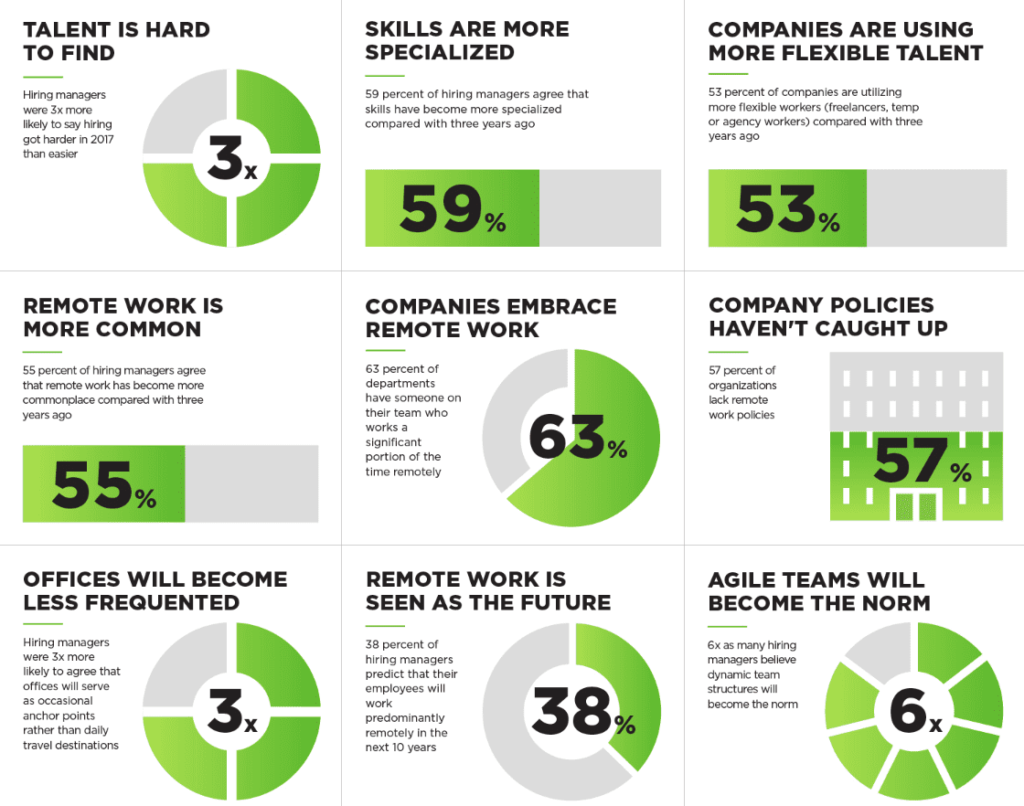In today’s rapidly evolving professional landscape, the future of work is not just about where we work, but how we work. For Pakistan’s freelancers, recruiters, educators, and professionals navigating platforms like Fiverr and Upwork, this evolution toward remote opportunities isn’t just a temporary adaptation but a permanent transformation. The rise of remote jobs and online working is reshaping job markets and operational methodologies across industries, heralding a new era where flexibility, technology, and globalization converge to redefine work itself.
Table of Contents
ToggleThe Future of Remote Work
Remote work, once a rare perk, has become a fundamental aspect of many professional landscapes. As businesses and employees navigate this new normal, understanding the trends and tools that will shape the future of remote work is crucial for continued growth and adaptation.
Emerging Trends in Remote Work
1. Increased Adoption Across Industries
The shift to remote work was initially most pronounced in tech and customer service roles, but we are now seeing its adoption across various sectors, including healthcare, education, finance, and even manufacturing.
2. Hybrid Work Models
Many organizations are adopting hybrid models, where employees split their time between working from home and an office. This model aims to balance flexibility with the benefits of in-person collaboration.
3. Focus on Work-Life Balance
As remote work blurs the lines between personal and professional life, there’s a growing emphasis on creating boundaries and supporting mental health.
4. Global Talent Access
Remote work removes geographical barriers, allowing companies to hire the best talent from around the world without relocation constraints.
5. Advanced Cybersecurity Measures
With the rise of remote work, there is an increased focus on cybersecurity. Protecting sensitive information outside the traditional office environment has become a top priority for businesses.
Key Tools for Remote Work
1. Communication Platforms
Tools like Slack, Microsoft Teams, and Zoom have become staples for remote workers, facilitating easy communication and collaboration across distances.
2. Project Management Software
Asana, Trello, and Monday.com help teams track project progress, manage tasks, and meet deadlines without the need for physical oversight.
3. Remote Desktop Applications
Tools like TeamViewer and RemotePC allow employees to access their work computers from any location, ensuring they have everything they need to perform their tasks.
4. Time Management Tools
With the flexibility of remote work, maintaining productivity can be challenging. Tools like RescueTime and Time Doctor provide insights into how work time is spent and offer features to help minimize distractions.
5. Cloud Storage and Collaboration
Google Drive, Dropbox, and OneDrive offer secure cloud storage options that enable real-time collaboration and file sharing among remote teams.
Embracing the Hybrid Model
At the heart of this transformation is the hybrid work model, an innovative approach that blends the flexibility of remote work with the tangible benefits of in-person engagement. Imagine a week diversified by location yet unified in purpose: Mondays ignite collaboration and team bonding within the office environment; Tuesdays and Thursdays are dedicated to deep work from the tranquility of a home office, while Wednesdays harness the power of technology to connect with clients and colleagues worldwide through video conferencing.
This model offers a compelling proposition for both employers and employees, combining the autonomy and flexibility that remote work advocates herald with the collaborative and social aspects of office life that traditionalists hold dear. It’s a balanced approach, recognizing that while technology can bridge gaps and enhance productivity, there is an inherent value in face-to-face interactions that foster team cohesion and spur innovation.
The Power of Choice
Central to the hybrid model’s appeal is the element of choice. It empowers individuals to tailor their work environments according to the task at hand, leveraging quiet home spaces for concentration and creativity, and office settings for teamwork and brainstorming sessions. This autonomy isn’t just a perk; it’s a paradigm shift, acknowledging that the one-size-fits-all mentality is obsolete. Workers are different—with varying preferences, responsibilities, and environmental sensitivities—and their best work occurs when they can align their tasks with the settings most conducive to success.
Technological Enablers
The seamless execution of the hybrid model relies on technological advancement. Digital platforms and tools have become the linchpins of remote work, enabling communication, collaboration, and productivity across distances. Tools like Zoom, Slack, and Microsoft Teams facilitate real-time communication and collaboration, while project management software like Trello and Asana help keep projects on track.
For the Pakistani workforce navigating the global digital landscape on platforms like Fiverr and Upwork, these tools are not just enablers but differentiators. They provide a competitive edge, allowing freelancers to connect with clients worldwide, manage projects efficiently, and deliver exceptional results—all without leaving their homes.
Future Trends
Looking ahead, several key trends are poised to shape the future of remote work:
- Increased Demand for Flexibility: Workers have tasted the benefits of flexibility and are unlikely to retreat from them entirely. Organizations will need to adapt to these expectations or risk losing talent to more agile competitors.
- Rise of Global Talent Pools: The move towards remote work has expanded the talent pool for companies, allowing them to recruit the best regardless of geographical boundaries. For workers in Pakistan and other emerging markets, this presents an unprecedented opportunity to access global job markets.
- Focus on Mental Health and Well-being: The blurred lines between work and home have highlighted the need for a greater focus on mental health and well-being. Future remote work policies will need to address these challenges, ensuring workers have the support and resources they need to thrive.
- Advancements in Remote Work Technology: We can expect further innovations in technology that facilitate remote work, from enhanced virtual reality meeting spaces to more sophisticated project management tools.
Conclusion
The future of remote work is not a distant speculation—it’s unfolding before our eyes. For Pakistan’s freelancers, educators, and professionals, the hybrid model and the technologies that support it offer a gateway to unprecedented flexibility and global opportunities. By harnessing these trends and tools, the Pakistani workforce can position itself at the forefront of the global digital economy, transforming challenges into opportunities in the evolving world of work. So, it is essential for individuals and organizations alike to embrace this paradigm shift and prepare for the exciting future of remote work. The possibilities are endless, and the future is now. Let’s embrace it together!
Read More: 5 Easy And Affordable Birthday Decoration Ideas At Home








